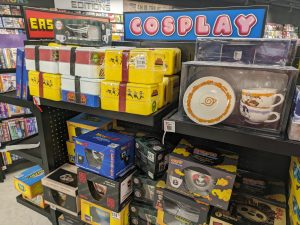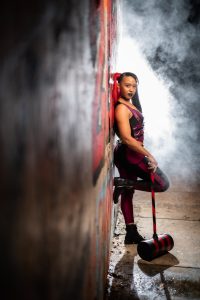Guide to Making Latex Cosplay Costumes & Outfits (DIY Guide)

Cosplay has become increasingly popular in recent years, with enthusiasts showcasing their creativity by dressing up as their favorite characters from movies, anime, video games, and more. One of the key aspects of creating a stunning cosplay outfit is choosing the right materials. Latex, known for its versatility and realistic appearance, has become a popular choice among cosplayers. In this guide, we will explore the process of making latex cosplay costumes and outfits from scratch, providing you with step-by-step instructions and helpful tips along the way.
Understanding Latex (rubber) as a Material for Cosplay Outfits
Latex is a natural material derived from the sap of the rubber tree. It possesses unique properties that make it ideal for creating cosplay outfits and rubber clothes. Latex (Rubber) is stretchable, durable, and can be molded into various shapes and forms. Additionally, it provides a glossy finish that adds a realistic touch to your cosplay outfit or rubber clothing. Before delving into the process of making a latex cosplay costume or rubber clothes, it is essential to familiarize yourself with the material’s characteristics and how it behaves during the crafting process. If you are interested in making more general latex clothing read our make your own latex clothing article.

DIY Cosplay Outfits
-
Stretchability and Flexibility:
Latex rubber is highly stretchable, allowing for comfortable movement in your cosplay outfit or rubber clothes. This flexibility ensures that your attire will not restrict your mobility during events or everyday wear. Whether you’re cosplaying a dynamic character or simply enjoying the comfort of rubber clothes, latex provides the necessary stretch to accommodate your movements.
-
Durability and Longevity:
Latex is known for its durability, making it an excellent choice for cosplay outfits and rubber clothes. It can withstand frequent wear and tear without losing its shape or integrity. This longevity ensures that your cosplay attire or rubber garments will stand the test of time, allowing you to enjoy them for various occasions and activities.
-
Malleability and Moldability:
One of the significant advantages of latex is its ability to be molded into various shapes and forms. This property allows you to create intricate designs and details for your cosplay outfit or rubber clothes. Whether you’re crafting a complex cosplay ensemble or fashioning unique rubber apparel, latex’s malleability and moldability enable you to bring your creative visions to life.
-
Glossy Finish:
Latex rubber naturally provides a glossy finish, giving your cosplay outfit or rubber clothes a distinctive and eye-catching appearance. This feature enhances the overall aesthetic and visual appeal of your attire, making it stand out among others. The glossy surface of latex also contributes to the illusion of different textures, adding depth and allure to your cosplay or rubber fashion.

DIY Rubber Cosplay Outfits
Tips on Understanding Latex (rubber) as a Material for Cosplay Outfits
| Properties | Benefits |
| Stretchability and Flexibility | Allows for comfortable movement and flexibility. |
| Durability and Longevity | Ensures the attire withstands frequent wear and tear. |
| Malleability and Moldability | Enables the creation of intricate designs and details. |
| Glossy Finish | Provides a realistic and visually appealing appearance. |
Understanding the properties of latex as a material for cosplay outfits and rubber clothes is crucial for successful costume construction and fashioning rubber garments. Its stretchability, durability, malleability, and glossy finish contribute to creating captivating and authentic attire. By harnessing these characteristics effectively, whether for cosplay or everyday rubber wear, you can express your creativity and individuality with confidence. Embrace the versatility of latex and explore the endless possibilities it offers for your cosplay adventures and rubber fashion choices.

DIY Sexy Latex Cosplay Outfit
What Do You Need to Make a Latex Cosplay Costume (materials, glue, pattern etc)
When it comes to making a latex cosplay costume, there are several key components and materials you will need to ensure a successful creation. From the right materials to the necessary tools, here’s a breakdown of what you’ll need:
I. Materials:
-
Latex sheeting:
This is the primary material used for creating latex cosplay costumes. It comes in various thicknesses and colors, allowing you to choose the one that suits your design.
-
Latex adhesive:
A high-quality latex adhesive is essential for bonding the latex sheets together and attaching various components of the costume.
-
Release agent:
To prevent the latex from sticking to itself during the construction process, a release agent is applied to the surface before working with the material.
-
Fabric for lining:
Adding a fabric lining to your costume helps improve comfort and ease of wear. Choose a breathable fabric that complements your design.
-
Accessories:
Depending on your cosplay character, you might need additional materials such as zippers, buckles, studs, or other embellishments.
II. Glue and Tools:
-
Paintbrushes:
Different sizes of paintbrushes will come in handy for applying latex adhesive and smoothing out the surface.
-
Scissors & Craft Knife:
A good pair of scissors or a craft knife is essential for cutting the latex sheets and fabric lining to the desired shape.
-
Latex thinner:
Used for thinning the latex adhesive, latex thinner allows you to achieve a smoother finish and better adhesion.
-
Heat gun:
A heat gun helps in shaping and molding the latex, creating intricate details and contours for your costume.
-
Latex repair kit:
Accidental tears or punctures can occur during the construction process, and a latex repair kit will help fix any damages effectively.
III. Pattern and Preparation:
- Costume pattern: Having a well-drafted pattern specific to your cosplay costume is crucial. You can either purchase a pattern or create one yourself based on your design.
- Measurements: Accurate body measurements are essential to ensure a proper fit. Take measurements of your body, including chest, waist, hips, and inseam, as per the pattern instructions.
- Preparing the workspace: Latex work can be messy, so it’s important to have a well-ventilated area with a clean, flat surface and good lighting. Protect your workspace with a drop cloth or plastic sheeting.

How to Make a Sexy Latex Cosplay Costume
Table of Tools Needed to Make Your Own DIY Latex Cosplay Costumes & Outfits
| Material/Tool | Purpose |
| Latex sheeting | Primary material |
| Latex adhesive | Bonding latex sheets |
| Release agent | Prevent sticking |
| Fabric lining | Enhanced comfort |
| Accessories | Additional embellishments |
| Paintbrushes | Applying latex adhesive |
| Scissors | Cutting materials |
| Latex thinner | Smoother finish |
| Heat gun | Shaping and molding |
| Latex repair kit | Fixing damages |
| Costume pattern | Guidance for construction |
| Measurements | Ensuring proper fit |
| Workspace setup | Clean and well-ventilated |
Remember, safety precautions should be followed when working with latex, such as using gloves and working in a well-ventilated area. With the right materials, tools, and attention to detail, you can bring your latex cosplay costume to life and showcase your creativity in the world of cosplay!
Preparing the Work Area and Safety Measures for Working with Latex in Cosplay
When working with latex in cosplay, it is important to establish a well-prepared work area and prioritize safety. This section provides guidance on setting up a dedicated work area, ensuring proper ventilation, gathering essential tools and supplies, and taking necessary safety precautions to avoid allergic reactions and inhalation of harmful fumes.
Establishing the Work Area
- Dedicated Space: Set up a dedicated work area specifically for your latex cosplay projects. This helps maintain organization and prevents any cross-contamination of materials or tools with other household items.
- Ventilation: Ensure the work area is well-ventilated to reduce the concentration of fumes. Open windows or use fans to promote air circulation and create a safer working environment.
- Protection for Surfaces: Cover your work surface with plastic sheets, drop cloths, or newspapers to protect it from spills, stains, or damage caused by latex or other materials used in the crafting process.
Essential Tools and Supplies
- Latex and Fabric: Have the necessary latex and fabric readily accessible within your work area. This allows for convenience and efficiency during the crafting process.
- Pattern-Making Materials: Keep pattern-making materials, such as paper, pattern drafting paper, or cardboard, nearby for creating and modifying patterns as needed.
- Cutting Tools: Have sharp scissors or rotary cutters within reach for cutting fabric, trimming excess latex, or making adjustments to the patterns.
- Brushes and Paints: Keep a selection of brushes of different sizes and types available for applying latex and any additional paints or detailing work.
- Additional Supplies: Depending on your specific cosplay design, gather any other necessary supplies such as closures, zippers, trims, or embellishments that may be required during the crafting process.
Safety Precautions
- Protective Gear: Prioritize your safety by wearing protective gloves, goggles, and a mask. Latex can cause allergic reactions in some individuals, so wearing gloves and goggles minimizes direct contact. Additionally, a mask helps prevent inhalation of any fumes or particles that may be released during the crafting process.
- Adequate Lighting: Ensure the work area is well-lit to prevent accidents or mishaps while working with tools or handling delicate materials.
- First Aid Kit: Keep a basic first aid kit nearby in case of any minor accidents or injuries that may occur during the crafting process.
- Storage and Disposal: Establish proper storage areas for latex, chemicals, and other materials. Dispose of waste and packaging in an appropriate manner, following local regulations and guidelines.

How To Make Your Own Latex Cosplay Outfits
Cosplay Latex & Rubber Clothing Making Preparation and Safety Considerations Table:
| Preparing the Work Area and Safety Measures | Key Steps |
| Establishing the Work Area | Set up a dedicated space, ensure ventilation, and protect surfaces. |
| Essential Tools and Supplies | Gather latex, fabric, pattern-making materials, cutting tools, brushes, and additional supplies. |
| Safety Precautions | Wear protective gear, ensure adequate lighting, and have a first aid kit available. |
Preparing the work area and implementing safety measures are crucial when working with latex in cosplay. By setting up a dedicated work area with proper ventilation, gathering essential tools and supplies, and taking necessary safety precautions, you create an environment that promotes efficient and safe crafting. Following these steps ensures a smooth and secure process for your latex cosplay projects, allowing you to focus on creating your desired costumes with peace of mind.
Choosing Which Latex Cosplay Costume to Make
When it comes to choosing a latex cosplay costume to make, there are several factors to consider. From selecting a character to planning your design, here’s a breakdown of the process:
I. Character Selection:
- Personal Interest: Choose a character that you are passionate about and feel a connection with. This will make the cosplay experience more enjoyable and fulfilling.
- Research: Explore different characters from your favorite anime, manga, video games, or movies. Consider their visual appeal, popularity, and uniqueness.
- Suitability: Assess whether the character’s costume is feasible to create with latex. Some designs may be too intricate or require advanced skills, so choose a costume that matches your abilities and resources.
II. Design Planning:
- Reference Images: Gather a collection of reference images that showcase different angles and details of the costume. This will help you accurately replicate the character’s outfit.
- Material Considerations: Determine if latex is the right material for your chosen costume. Consider factors such as comfort, flexibility, and the ability to achieve the desired look.
- Customization: Decide if you want to add your own creative touch to the costume. This could involve incorporating unique color schemes, patterns, or modifying certain elements to make the costume stand out.
III. Practical Considerations:
- Budget: Evaluate the cost of materials, tools, and accessories required for the cosplay. Latex can be relatively expensive, so ensure it fits within your budget.
- Time and Skill: Assess the amount of time and level of expertise needed to create the costume. If you have limited experience, choose a costume that matches your skill level and gives you room to learn and improve.
- Event or Occasion: Consider where you plan to wear the cosplay costume. Will it be for a convention, cosplay competition, or a casual event? Make sure your costume choice aligns with the occasion and any specific guidelines or themes.

Latex Cosplay Outfits Vs Store Bought Cosplay Costumes
Steps in Choosing Which Latex Cosplay Character Outfit to Make
| Factor | Considerations |
| Personal Interest | Choose a character you’re passionate about |
| Research | Explore characters from your favorite sources |
| Suitability | Assess the feasibility and complexity of the costume |
| Reference Images | Gather a variety of images for accurate replication |
| Material Considerations | Evaluate if latex is suitable for the design |
| Customization | Decide if you want to add your unique touch to the costume |
| Budget | Evaluate the cost of materials, tools, and accessories |
| Time and Skill | Assess the level of expertise and time commitment required |
| Event or Occasion | Consider the purpose and theme of the event where you’ll wear it |
Remember, the most important aspect of choosing a latex cosplay costume is to have fun and express your creativity. Whether you decide to recreate a well-known character or put your unique spin on a design, the process of selecting and planning your cosplay is an exciting part of the overall experience.
Popular Latex Cosplay Costumes
Latex cosplay costumes have gained significant popularity in recent years, thanks to their sleek and alluring appearance. Whether you’re a fan of comic books, movies, or video games, latex cosplay costumes offer a wide range of options to bring your favorite characters to life. Here are some popular choices that have captivated cosplay enthusiasts around the world.
Superhero Latex Cosplay Costumes
- Wonder Woman: The iconic superheroine has inspired numerous latex cosplay costumes, featuring her signature red, gold, and blue outfit. With a form-fitting design and intricate details, these costumes exude power and confidence.
- Batman: The Dark Knight’s latex cosplay costumes replicate his sleek armor and bat symbol. These outfits often come with a cape, utility belt, and mask, allowing fans to embody Gotham City’s protector.
- Spider-Man: Latex cosplay costumes based on the web-slinger typically showcase the character’s red and blue attire, complete with intricate web patterns. The costumes often include a mask to conceal the wearer’s identity.

Latex Homemade Cosplay Costume
Fantasy and Sci-Fi Latex Cosplay Costumes
- Star Wars: Characters like Darth Vader and Stormtroopers are popular choices for latex cosplay costumes. The dark and imposing armor of these characters is faithfully recreated in latex, allowing fans to embrace the dark side or join the ranks of the Galactic Empire.
- Game of Thrones: Fans of the epic fantasy series can find latex cosplay costumes inspired by characters like Daenerys Targaryen, Jon Snow, or the Night King. These costumes capture the elaborate designs and distinctive aesthetics of the show.
- Anime: Numerous anime characters, such as Sailor Moon and Naruto, have latex cosplay costumes available. These outfits often feature vibrant colors, intricate patterns, and exaggerated elements that reflect the unique style of anime.
Villains and Anti-Heroes Latex Cosplay Costumes
- Harley Quinn: The iconic DC Comics character has become a cosplay favorite, with her mischievous and unpredictable personality. Latex cosplay costumes inspired by Harley Quinn often include her trademark red and black color scheme and diamond patterns.
- Deadpool: Known for his irreverent humor and fourth-wall-breaking antics, Deadpool has a distinctive red and black latex suit. Cosplayers can find detailed replicas that capture the character’s unique style and accessories.
- Catwoman: The feline anti-heroine from the Batman universe is another popular choice for latex cosplay costumes. These outfits highlight Catwoman’s sleek and seductive persona, often featuring a form-fitting bodysuit, mask, and cat ears.
How to Choose the Latex Rubber Cosplay Outfit to Make
| Cosplay Costume | Features | Popular Characters |
| Wonder Woman | Red, gold, and blue design, intricate details | Wonder Woman |
| Batman | Sleek armor, bat symbol, cape, utility belt | Batman |
| Spider-Man | Red and blue with web patterns, includes mask | Spider-Man |
| Darth Vader | Dark and imposing armor | Darth Vader |
| Stormtrooper | White armor | Stormtroopers |
| Daenerys Targaryen | Elaborate design, show-inspired aesthetics | Daenerys Targaryen (Game of Thrones) |
| Harley Quinn | Red and black color scheme, diamond patterns | Harley Quinn |
| Deadpool | Red and black suit, unique style | Deadpool |
| Catwoman | Form-fitting bodysuit, mask, cat ears | Catwoman |
In summary, latex cosplay costumes offer a wide range of options for fans to embody their favorite characters. From superheroes to fantasy and sci-fi icons, and even villains and anti-heroes, these costumes provide an opportunity to showcase creativity and pay homage to beloved pop culture figures.

Make Your Own Latex Cosplay Outfits
How Much Do Latex Cosplay Costumes Cost to Make
Creating latex cosplay costumes involves various factors that contribute to the overall cost of the production. From materials and labor to intricate details and customization, the expenses can vary significantly. This section aims to provide an overview of the factors influencing the cost of making latex cosplay costumes.
Materials and Supplies
- Liquid Latex & Latex Sheeting: The primary material used in creating latex cosplay costumes is latex itself. The cost of latex can vary depending on the quality, thickness, and color desired for the costume.
- Mold-making Materials: If molds are used to create intricate designs, the cost of mold-making materials such as silicone or plaster needs to be considered.
- Accessories: Additional materials like zippers, hooks, and eyelets may be required for functional and aesthetic purposes, adding to the overall cost.
Labor and Craftsmanship
- Design and Pattern Making: The process of designing and creating patterns for latex cosplay costumes requires skill and expertise. The cost can vary depending on the complexity of the design and the time required for pattern development.
- Construction and Assembly: The labor involved in cutting, shaping, and assembling the latex pieces into a cohesive costume contributes to the overall cost. The intricacy of the design and the level of craftsmanship required can affect the labor charges.
Customization and Detailing
- Custom Designs: If the cosplay costume involves custom designs or modifications, the cost will be higher due to the additional time and effort required for personalization.
- Intricate Details: Costumes with intricate details such as textured surfaces, hand-painted elements, or additional accessories will require more labor and skill, resulting in increased costs.
- Additional Services: Depending on the complexity of the costume, additional services like airbrushing, body painting, or special effects makeup may be needed, which can add to the overall expenses.
Comparing the Costs of Making a Latex Cosplay Outfit
| Cost Factor | Description |
| Materials and Supplies | Includes the cost of latex, mold-making materials, and other necessary items. |
| Labor and Craftsmanship | Encompasses design, pattern making, construction, and assembly labor charges. |
| Customization and Detailing | Refers to the cost associated with personalized designs, intricate details, and additional services. |
It is important to note that the cost of making latex cosplay costumes can vary significantly based on individual preferences, complexity, and customization. While some costumes can be relatively affordable, others with intricate designs or specialized craftsmanship may require a higher investment. Additionally, purchasing pre-made latex cosplay costumes from professional costume designers or sellers can also affect the overall cost. It is advisable to consider budgetary constraints and evaluate the value of the craftsmanship and materials involved when determining the cost of making latex cosplay costumes.
Cost of Latex Cosplay Costumes vs Making Your Own Latex Outfit (DIY)
When it comes to latex cosplay costumes, enthusiasts have two main options: purchasing a pre-made outfit or making their own latex outfit through a DIY approach. Each method has its own considerations and costs. This section aims to provide an overview of the cost factors associated with buying pre-made latex cosplay costumes and making your own latex outfit.
Pre-Made Latex Cosplay Costumes
- Cost Range: Pre-made latex cosplay costumes can vary in price depending on factors such as the complexity of the design, quality of materials, and the reputation of the designer or seller. Prices can range from affordable options to higher-end costumes.
- Factors Influencing Cost: The cost of pre-made latex cosplay costumes is influenced by several factors, including the intricacy of the design, level of craftsmanship, quality of materials, and any additional accessories or customization options.
- Purchasing Considerations: When buying a pre-made latex cosplay costume, it’s essential to consider factors such as size availability, shipping costs, and return policies. Additionally, checking customer reviews and ratings can help gauge the quality and value for money.
Making Your Own Latex Outfit (DIY)
- Materials: The cost of making a latex outfit through a DIY approach involves purchasing the necessary materials, including latex, mold-making supplies, accessories, and any additional embellishments. The cost can vary depending on the quality and quantity of materials required.
- Tools and Equipment: DIY enthusiasts may need to invest in tools and equipment such as pattern-making tools, scissors, brushes, and airbrushing equipment. These one-time expenses should be factored into the overall cost of making a latex outfit.
- Time and Skill: DIY projects require time and skill. While making your own latex outfit can be a fulfilling and creative process, it’s important to consider the time investment required to learn and execute the techniques properly.
Comparing the Cost of Home-Made DIY Latex Cosplay Costumes Vs Store Bought Cosplay Latex Outfits
| Cost Factors | Pre-Made Latex Cosplay Costumes | Making Your Own Latex Outfit (DIY) |
| Cost Range | Varies depending on the costume | Varies depending on materials, tools, and accessories |
| Influencing Factors | Complexity, craftsmanship, materials, accessories | Materials, tools, and additional embellishments |
| Additional Considerations and Investment | Size availability, shipping costs, return policies | Tools, equipment, time investment, skill development |
The cost of latex cosplay costumes depends on whether you choose to purchase a pre-made outfit or make your own latex outfit through a DIY approach. Pre-made costumes offer convenience and varied quality options, with prices ranging from affordable options to higher-end costumes. On the other hand, making your own latex outfit requires an investment in materials, tools, and time, allowing for customization and creative expression. The cost of a DIY latex outfit can vary based on the chosen materials, tools, and any additional embellishments or accessories. Ultimately, the decision between buying a pre-made outfit or making your own latex cosplay costume depends on personal preferences, budget constraints, and the desire for customization and creative control.
Designing Your Latex Cosplay Costume
Before starting the creation process, designing your cosplay costume is a crucial step that sets the foundation for bringing your favorite character to life. This section aims to provide guidance on how to approach the design phase effectively and create a visually accurate and captivating cosplay costume.
Research and Reference Gathering
- Character Analysis: Begin by thoroughly understanding the character you want to cosplay. Study their appearance, personality, and backstory to capture the essence of the character in your design.
- Reference Images: Collect reference images from various sources, such as comics, movies, or video games. Gather a range of images that showcase different angles, details, and variations of the character’s costume.
- Study Materials: Analyze the materials used in the character’s outfit. Consider the texture, colors, and patterns that define their attire. This information will help in selecting appropriate materials for your cosplay costume.
Conceptualization and Sketching
- Idea Generation: Use the reference images and your understanding of the character to generate ideas for your costume design. Consider elements like color schemes, silhouette, and any unique accessories or props associated with the character.
- Sketching: Translate your ideas into rough sketches. These initial sketches will help visualize the overall design and serve as a basis for further refinement. Experiment with different variations and poses to find the most visually appealing composition.
Pattern-Making and Detailing
- Pattern Development: Using the sketches as a guide, create patterns for the different components of your cosplay costume. This includes pieces like bodices, sleeves, pants, and accessories. Ensure the patterns accurately reflect the proportions and shape of the character’s outfit.
- Material Selection: Choose materials that align with your design and match the character’s attire. Consider factors such as drape, sheen, and durability when selecting fabrics and other materials for construction.
- Detailing and Embellishments: Pay attention to the intricate details of the character’s costume. This can include elements like embroidery, appliqué, trims, or specific accessories. Incorporate these details into your design to add authenticity and capture the essence of the character.
Key Points In Choosing and Designing your Home-Made DIY Latex Cosplay Outfit
| Designing Your Cosplay Costume | Key Points |
| Research and Reference Gathering | Understand the character, collect reference images, and study materials used. |
| Conceptualization and Sketching | Generate ideas, create rough sketches, and experiment with different variations. |
| Pattern-Making and Detailing | Develop patterns, select appropriate materials, and incorporate intricate details. |
Designing your cosplay costume is a vital part of the creative process. Through thorough research, gathering reference materials, and analyzing the character’s attire, you can gain a deep understanding of the design elements you wish to incorporate. Conceptualization and sketching help translate your ideas into visual representations, allowing you to refine the design before moving on to pattern-making and detailing. By following these steps, you can ensure a visually accurate and captivating cosplay costume that truly embodies the character you admire.

Make Your Own Latex Cosplay Outfits
Creating a Pattern
When When crafting a latex cosplay costume or outfit, creating a well-fitted pattern is essential. This stage establishes the foundation for constructing your latex clothing and ensures a precise and comfortable fit. The following guide provides a step-by-step approach to help you create a pattern for your latex cosplay costume.
- Taking Accurate Measurements: Begin by taking accurate measurements of your body. Use a measuring tape to record the circumference of your chest, waist, hips, and any other relevant areas. Note down these measurements to reference them during the pattern-making process.
- Drafting the Base Pattern: Start by drafting the base pattern, which serves as the foundation for your costume. Use a pattern paper or cardboard to create a template. Trace the outline of your body measurements, ensuring to maintain a snug fit without being too tight.
- Creating Design Details: Once the base pattern is complete, you can add design details to customize your costume. This includes incorporating elements such as collars, sleeves, or intricate shapes. Sketch these details onto the pattern, keeping in mind the overall aesthetic you want to achieve.
- Test Fitting and Adjustments: After drafting the pattern, it’s crucial to conduct a test fitting to ensure the accuracy and comfort of the design. Transfer the pattern onto a mock-up fabric and sew it together. Try it on and make any necessary adjustments, such as altering seam placements or modifying the shape to achieve the desired fit.
- Finalizing the Pattern: Once you are satisfied with the fit and design, transfer the modified pattern onto a sturdy material, such as cardboard or clear plastic. This final pattern will serve as your reference for cutting and shaping the latex material.
Key Steps in Designing and Making a Pattern for Your Home Made DIY Latex Rubber Cosplay Outfit
| Steps | Key Considerations |
| Taking Accurate Measurements | Ensure measurements are precise and reflect your body shape accurately. |
| Drafting the Base Pattern | Maintain a snug fit without compromising comfort. |
| Creating Design Details | Incorporate design elements that align with your desired aesthetic. |
| Test Fitting and Adjustments | Make necessary alterations to achieve the desired fit. |
| Finalizing the Pattern | Transfer the modified pattern onto a sturdy material for durability. |
By following these steps and considering the key considerations mentioned above, you can create a well-fitted pattern for your latex cosplay costume. This process ensures that your costume will fit comfortably and accurately reflect your desired design. Remember to be meticulous during the pattern-making stage, as it lays the groundwork for a successful construction process. With a well-fitted pattern in hand, you are ready to move on to the next stages of crafting your latex cosplay costume and bringing your favorite characters to life.

Making DIY Latex Cosplay Outfits
Measurements and Blueprint
- Accurate Body Measurements: Begin by taking precise measurements of your body using a measuring tape. Key areas to measure include the bust, waist, hips, shoulders, and inseam. These measurements will serve as a basis for creating the pattern.
- Transferring Measurements: Transfer the measurements onto pattern-making materials, such as paper or pattern tracing paper. Use a pencil or tailor’s chalk to mark the measurements accurately.
- Basic Template: Using the transferred measurements, create a basic template by connecting the marks. This template will form the foundation of your pattern and represent your body’s proportions.
Refining the Pattern
- Adding Design Elements: Refine the basic template by adding design elements to match the character’s attire. This includes seams, darts, pleats, or any distinctive structural features. These design elements ensure the pattern reflects the character’s outfit accurately.
- Mock-up and Fittings: Create a mock-up of the pattern using inexpensive fabric or muslin. This allows you to test the fit and make any necessary adjustments. Conduct fittings to ensure the pattern aligns with your body shape and captures the desired look.
- Fine-tuning: Based on the mock-up fittings, make adjustments to the pattern. This may involve taking in or letting out seams, modifying the shape of darts, or altering the length and width of certain parts. Refine the pattern until you achieve the desired fit.
Finalizing the Pattern
- Tracing the Final Pattern: Once the pattern has been refined and adjusted, transfer it onto sturdier pattern-making materials, such as cardboard or pattern drafting paper. Use a fine pen or marker to trace the final pattern, ensuring clarity and durability.
- Markings and Notations: Add necessary markings and notations to the pattern, such as grainlines, seam allowances, and placement marks for closures or accessories. These details are crucial during the construction phase.
- Multiple Patterns: Depending on the complexity of your cosplay costume, you may need separate patterns for different components, such as tops, bottoms, sleeves, or accessories. Label and organize these patterns accordingly.
How to Create a Pattern for Making your Own Latex Rubber Cosplay Costume
| Creating a Pattern for Latex Clothing | Key Steps |
| Measurements and Blueprint | Take accurate body measurements and transfer them onto pattern-making materials. |
| Refining the Pattern | Add design elements, conduct fittings, and make necessary adjustments. |
| Finalizing the Pattern | Trace the final pattern onto durable materials, add markings, and create separate patterns as needed. |
Creating a pattern for your latex cosplay costume is a crucial step that ensures a precise fit and brings your design to life. By accurately measuring your body, transferring those measurements onto pattern-making materials, and refining the pattern with design elements, you can achieve a pattern that captures the character’s outfit accurately. Fittings and adjustments using mock-ups help fine-tune the pattern for a comfortable fit. Finalize the pattern by tracing it onto durable materials and adding necessary markings and notations. With a well-crafted pattern in hand, you are ready to move on to the construction phase of your latex cosplay costume.
Acquiring and Preparing the Latex
To create your latex cosplay costume, it is important to acquire and prepare the liquid latex properly. This section provides guidance on acquiring the necessary liquid latex, performing a patch test, mixing the latex, and eliminating air bubbles before applying it to the fabric.
Acquiring Liquid Latex
- Sourcing Liquid Latex: Liquid latex can be obtained from specialty cosplay supply stores, online retailers, or local art supply shops. Ensure you purchase a suitable quantity based on your costume design and the areas you intend to cover with latex.
- Color and Finish Options: Liquid latex comes in a range of colors and finishes, including matte, glossy, metallic, or even translucent. Select a color and finish that best matches your desired cosplay costume appearance and the character you are portraying.
Patch Test and Thickness Determination
- Patch Test: Before applying liquid latex to your entire fabric or costume, perform a patch test on a small, inconspicuous piece of material. Apply a thin layer of latex and let it dry completely. Check for any adverse reactions or discoloration to ensure compatibility with the fabric.
- Thickness Consideration: Determine the desired thickness of the latex layer for your cosplay costume. Thicker layers provide more durability and coverage, while thinner layers offer more flexibility. Experiment with different layer thicknesses during the patch test to find the optimal balance for your needs.
Mixing and Eliminating Air Bubbles
- Mixing the Latex: Follow the manufacturer’s instructions on the liquid latex container for proper mixing ratios. Typically, it involves shaking or stirring the liquid latex to ensure uniformity. Some liquid latex products may require the addition of a curing agent or pigment, so be sure to follow the instructions carefully.
- Letting the Latex Rest: After mixing the liquid latex, let it sit for a few minutes. This resting period helps eliminate air bubbles that may have formed during the mixing process. Gently tap the container or stir the latex to further release any trapped air bubbles.
- Removing Air Bubbles: To remove any remaining air bubbles, use a foam brush or a small spatula to skim the surface of the latex before application. This helps ensure a smoother and more even layer when applying the latex to the fabric.
Tips on Buying and Preparing Latex for Cosplay Costumes
| Acquiring and Preparing Liquid Latex | Key Steps |
| Acquiring Liquid Latex | Source liquid latex from cosplay supply stores or online retailers. |
| Patch Test and Thickness Determination | Perform a patch test and determine the desired thickness for the latex. |
| Mixing and Eliminating Air Bubbles | Follow the manufacturer’s instructions for mixing and remove air bubbles. |
Acquiring and preparing the liquid latex is an important step in creating a latex cosplay costume. By sourcing liquid latex of suitable color and finish, performing a patch test to ensure fabric compatibility, and determining the desired thickness, you can ensure a successful outcome. Following the manufacturer’s instructions for mixing the liquid latex, letting it rest to eliminate air bubbles, and using techniques to remove any remaining bubbles are crucial to achieving a smooth and flawless application. With properly acquired and prepared liquid latex, you are ready to move forward with applying the latex to your fabric and bringing your cosplay costume to life.
Applying Liquid Latex to the Fabric
The process of applying liquid latex to fabric is a crucial step (if you are not using sheet latex for your design, or if you are wanting to use a cloth to support the seams and stress areas in a sheet latex outfit) in creating cosplay costumes with realistic and durable finishes. This section provides a step-by-step guide on how to apply latex effectively, ensuring smooth and even coverage, gradual thickness buildup, and reinforcement of key areas.
Tools and Materials
- Brush or Sponge: Choose a brush or sponge suitable for applying latex to the fabric. Soft-bristle brushes or cosmetic sponges are commonly used for achieving an even application.
- Latex and Fabric: Ensure you have the necessary latex and fabric readily available. Choose latex that is compatible with your fabric type and desired finish.
- Thin and Even Layers: Start by applying a thin layer of latex to the fabric using a brush or sponge. Work in small sections, ensuring smooth and even coverage. Avoid applying excessive pressure that may cause the latex to pool or create uneven patches.
- Base Layers and Drying Time: Apply the base layers of latex, allowing each layer to dry completely before adding additional coats. This drying time ensures that subsequent layers adhere properly and prevents smudging or peeling.
- Gradual Thickness Buildup: Gradually build up the thickness of the latex layers by applying additional coats. Follow the contours of your pattern to maintain the desired shape and structure of the cosplay costume. Ensure each layer is dry before proceeding to the next.
- Reinforcing Key Areas: Pay special attention to areas that require reinforcement or extra flexibility, such as joints or seams. Apply an additional layer of latex to these areas to provide durability and ensure the costume can withstand movement without tearing or stretching excessively.
Curing and Finishing
- Curing Time: Allow the latex to cure between each layer. The curing time may vary based on factors such as temperature, humidity, and thickness of the applied latex. Refer to the manufacturer’s instructions for recommended curing times to achieve optimal strength and durability.
- Final Touches and Detailing: Once the desired thickness is achieved, perform any final touches or detailing work, such as smoothing rough edges, adding texture, or creating specific effects. Use brushes or sponges to apply latex in a controlled manner for these finishing touches.
- Full Curing: Allow the latex to fully cure before handling or wearing the cosplay costume. This ensures that the latex is fully dried and bonded to the fabric, providing the desired strength and durability.
Step by Step Guide to Applying Liquid Latex (Rubber) to Cloth to Make a Cosplay Outfit
| Applying Latex to the Fabric | Key Steps |
| Tools and Materials | Select appropriate brush or sponge and gather latex and fabric. |
| Applying Latex | Apply thin and even layers, allow drying between coats, and gradually build thickness. |
| Curing and Finishing | Allow each layer to cure, perform final touches, and ensure full curing before use. |
Applying latex to the fabric is a critical step in creating realistic and durable cosplay costumes. By using the right tools, applying thin and even layers, gradually building up the thickness, and reinforcing key areas, you can achieve a smooth and precise finish. Allowing each layer to dry and fully cure ensures optimal strength and durability. Finally, performing any final touches and detailing work before the full curing process adds the desired effects and completes the cosplay costume. With careful application and curing, your latex-coated fabric will be ready for further steps in the creation process.
Adding Details and Accessories
Once Once you have completed the base layers of your cosplay costume, it’s time to elevate it by adding intricate details and accessories. These additions can take your cosplay to the next level and make it truly stand out. Here are some tips and ideas on how to add those finishing touches:
Use Additional Materials:
-
- Incorporate materials like foam, fabric, or thermoplastics to create three-dimensional elements.
- These materials are affordable and versatile, allowing you to craft armor, props, or decorative embellishments.
Create Three-Dimensional Elements:
-
- Experiment with foam to make armor pieces, such as chest plates, shoulder pads, or helmets.
- Utilize fabric to craft capes, belts, or decorative accents that enhance the overall look of your cosplay.
- Thermoplastics, like Worbla or EVA foam, can be shaped and molded into intricate details and accessories.
Secure Attachments:
-
- Ensure that the additional elements are securely attached to your costume.
- Use latex or suitable adhesives to bond the pieces firmly, ensuring they withstand movement and activities during cosplay.
Tips for adding Accessories to Your Rubber & Latex DIY Cosplay Outfits
| Tips | Benefits |
| Use Additional Materials | Provides versatility in creating three-dimensional elements |
| Create Three-Dimensional Elements | Adds depth and realism to your cosplay costume |
| Secure Attachments | Ensures durability and stability of the added details |
By adding intricate details and accessories to your cosplay costume, you can bring your character to life and make your outfit visually striking. These additions allow you to showcase your craftsmanship and attention to detail. With the right materials and secure attachments, your cosplay will be complete with all the finishing touches that truly make it stand out.
Painting and Coloring the Latex/Rubber
Once the latex has fully cured, it’s time to unleash your creativity by painting and coloring your cosplay costume. This step allows you to customize the appearance of your costume and bring your character to life with vibrant colors and visual effects. Here are some tips and techniques to help you achieve the desired results:
Choose the Right Painting Materials:
-
- Acrylic paints, fabric dyes, and airbrush techniques are commonly used to paint latex and rubber materials.
- Acrylic paints offer a wide range of colors and are easy to work with. Fabric dyes can provide vibrant and long-lasting results. Airbrushing allows for smoother and more precise application.
Apply Multiple Layers:
-
- Start by applying a base layer of paint that matches the overall color scheme of your character.
- Build up the colors gradually by applying multiple layers of paint, allowing each layer to dry thoroughly before adding the next one.
- This layering technique adds depth and dimension to your cosplay outfit, giving it a more realistic and professional look.
Experiment with Techniques and Effects:
-
- Explore different painting techniques such as shading, highlighting, or blending to create more intricate details.
- Consider adding weathering effects, such as scratches, stains, or fading, to enhance the realism of your costume.
- Incorporate special effects like metallic finishes, glow-in-the-dark paint, or texture paints to make your cosplay truly unique.
Tips for Adding Color and Painting Your DIY Homemade Latex Cosplay Costume
| Tips | Benefits |
| Choose the Right Painting Materials | Offers versatility and options for desired effects |
| Apply Multiple Layers | Adds depth and dimension to the cosplay outfit |
| Experiment with Techniques | Allows for customization and unique visual effects |
By painting and coloring your latex/rubber cosplay costume, you can elevate its appearance and make it truly stand out. The choice of materials, layering technique, and experimentation with different effects allow you to customize your cosplay to match your character’s aesthetics. Let your creativity shine as you bring your cosplay to life with vibrant colors and intricate details.
Caring for Your Latex (Rubber) Cosplay Costume
Proper care and maintenance are essential to ensure the longevity of your latex cosplay costume. By following these guidelines, you can keep your costume in excellent condition and extend its lifespan:
Storage:
-
- Store your latex cosplay costume in a cool, dry place away from direct sunlight.
- Avoid folding or creasing the costume for extended periods, as this can cause permanent damage.
- Consider using a garment bag or a dedicated storage container to protect it from dust and potential damage.
Handling and Protection:
-
- Avoid exposing your costume to sharp objects or rough handling that could result in tears or punctures.
- When putting on or taking off the costume, be gentle and avoid excessive stretching or pulling.
- If necessary, use a dressing aid like talcum powder to ease the process of wearing the latex.
Cleaning and Maintenance:
-
- Regularly clean the surface of your costume using a damp cloth or mild soap to remove dust or debris.
- Do not use harsh chemicals or solvents, as they can damage the latex material.
- After cleaning, ensure that the costume is completely dry before storing it to prevent mold or mildew.
Maintenance of Glossy Finish:
-
- To maintain the glossy finish of your latex cosplay costume, apply a silicone-based polish.
- This polish will help keep the latex supple and prevent it from becoming brittle over time.
- Follow the manufacturer’s instructions for application and use it sparingly to avoid excessive buildup.
Tips on Maintaining your Latex Rubber Cosplay Costume
| Care Guidelines | Benefits |
| Proper Storage | Prevents degradation and protects from damage |
| Gentle Handling and Protection | Minimizes the risk of tears or punctures |
| Regular Cleaning and Maintenance | Keeps the costume clean and free from debris |
| Maintenance of Glossy Finish | Preserves the latex’s suppleness and prevents brittleness |
By following these care guidelines, you can maintain the quality and appearance of your latex cosplay costume for years to come. With proper storage, handling, and regular cleaning, your costume will stay in great condition, ready to be worn and enjoyed at future cosplay events.
Making a Rubber Cosplay Outfit & Costume on a Tight Budget
Creating a rubber cosplay outfit and costume can be an exciting endeavor, but it’s no secret that the cost of materials and accessories can quickly add up. However, with a little ingenuity and resourcefulness, it’s possible to bring your cosplay dreams to life even on a tight budget. In this guide, we will explore tips and techniques to help you make a stunning rubber cosplay outfit without breaking the bank. Discover affordable alternatives, creative ideas, and cost-saving strategies for your next cosplay adventure.
Tips on How to Make Cheap Latex Rubber Cosplay Outfits
Latex rubber cosplay outfits can be expensive to buy, but with a little creativity and resourcefulness, you can make your own cheap latex costumes. Here are some tips to help you create affordable and unique latex rubber cosplay outfits:
Use Balloons:
-
- Balloons can be a great option if you’re looking to create a one-time cosplay outfit.
- Keep in mind that cosplay costumes made from balloons will not last more than a week, so this is ideal for short-term use or one-time events.
Create an outfit using latex rubber fitness bands:
-
- Using fitness bands made of latex rubber can be a fun and cost-effective way to make a long-lasting latex cosplay costume.
- By selecting different colors and patterns of fitness bands, you can create a unique and personalized outfit.
Use latex sheet samples:
-
- Some sellers of latex clothes sheets offer samples for people to see the color and thickness of the material.
- Take advantage of these latex sheet samples and be adventurous by combining different cloth and latex rubber clothing sheet samples to create an affordable and customized cosplay outfit.
Use a mix of cloth and liquid latex:
-
- Using a cloth base for your cosplay outfit can significantly reduce the cost of making a rubber cosplay outfit.
- By applying liquid latex onto the cloth base, you can achieve a rubber-like appearance while keeping the costs low.
- This method allows you to experiment with different fabric textures and colors, giving your cosplay outfit a unique look.
Tips For Making Cheap Latex & Rubber Cosplay Costumes on a Budget
| Tips | Benefits |
| Use Balloons | Quick and inexpensive solution for one-time cosplay events |
| Latex Rubber Fitness Bands | Fun and cost-effective with the possibility of customization |
| Latex Sheet Samples | Explore color and thickness options before making a purchase |
| Mix of Cloth and Liquid Latex | Affordable approach with versatility in fabric and appearance |
Cheap Cosplay Ideas:
Creating a stunning cosplay outfit and accessories doesn’t have to break the bank. With a little creativity and smart shopping, you can make latex rubber cosplay outfits on a tight budget. Here are some affordable ideas to help you bring your cosplay dreams to life without draining your wallet:
Utilize Thrift Stores and Clearance Sales:
-
- Thrift stores are treasure troves for finding clothing items and accessories that can be repurposed for cosplay outfits.
- Keep an eye out for clearance sales at retail stores, as they often offer significant discounts on clothing and accessories that can be modified or used as is for your cosplay.
DIY Latex Rubber Accessories:
-
- Making your own latex rubber accessories can save you money while allowing for customization.
- Explore tutorials and guides online to learn how to create items like gloves, masks, armor pieces, and props using liquid latex and other inexpensive materials.
Combine Latex with Affordable Fabrics:
-
- Instead of creating an entire outfit using solely latex rubber, consider incorporating affordable fabrics like spandex, cotton, or polyester.
- Use latex strategically for specific elements, such as body suits, gloves, or boots, while using fabric for the rest of the outfit.
Tips for Cheap Cosplay Accessories for Your Latex Cosplay Costume
| Ideas | Benefits |
| Thrift Stores | Affordable options for clothing and accessories |
| DIY Latex Rubber Accessories | Customization and cost-saving potential |
| Latex and Affordable Fabrics | Versatility in design and reduced material costs |
By implementing these cheap cosplay outfit and accessory ideas, you can bring your favorite characters to life without breaking the bank. Embrace your creativity and resourcefulness to make stunning latex rubber cosplay outfits that are both affordable and impressive.
Key Take Aways from the Guide to Making You Own DIY Latex Rubber Cosplay Costume Or Outfit
Creating a DIY latex rubber cosplay costume or outfit requires careful planning and attention to detail. The following key takeaways from the guide will provide you with valuable insights and tips to help you successfully undertake this creative endeavor.
Key Takeaways:
- Understanding Latex Properties: Latex rubber has unique properties that make it ideal for creating cosplay costumes. It is flexible, durable, and can be molded to fit any shape (Latex looks great on all sizes! See our section on BBW Latex Clothes for ideas for larger bodies) or design. Understanding these properties will enable you to work with latex effectively.
Latex rubber is highly stretchable, allowing for comfortable movement in your costume. However, it is important to avoid overstretching the material during the construction process to prevent tearing.
- Preparing the Latex: Properly preparing the latex is crucial to ensure a smooth and professional-looking finish. This includes cleaning the latex, applying a release agent, and using a mold or pattern to shape the material.
Cleaning the latex involves removing any dust, debris, or residue from the surface. Applying a release agent, such as talcum powder, will prevent the latex from sticking to itself or the mold during the curing process.
- Building a Solid Foundation: Creating a strong foundation for your latex costume is essential for its longevity and comfort. This involves using reinforcement techniques, such as adding support structures or embedding fabric into the latex layers.
Reinforcement helps prevent the costume from sagging or stretching too much over time. By strategically placing support structures and incorporating fabric, you can enhance the structural integrity of your costume.
- Proper Application Techniques: Applying latex rubber requires precision and patience. Using a brush or sponge, gradually build up layers of latex onto the mold or pattern, allowing each layer to dry before applying the next. This technique ensures an even and smooth finish.
It is essential to work in a well-ventilated area and wear appropriate protective gear, such as gloves and a mask, when working with latex. This will protect you from potential allergic reactions and fumes emitted during the application process.
- Finishing Touches: Once the latex layers are complete, additional finishing touches can enhance the overall appearance of your cosplay costume. These can include painting, detailing, and adding accessories or embellishments.
Painting the latex allows you to bring your design to life by adding colors and textures. Consider using high-quality latex paints that are flexible and durable. Adding accessories, such as belts or armor pieces, can further elevate your costume’s authenticity.
Table of Key Takeaways:
| Key Takeaways | What You Will Learn |
| Understanding Latex Properties | The unique properties of latex and how to work with them effectively |
| Preparing the Latex | Cleaning, applying release agent, and shaping the latex properly |
| Building a Solid Foundation | Reinforcement techniques for structural integrity |
| Proper Application Techniques | Applying latex in layers with precision and patience |
| Finishing Touches | Enhancing your costume’s appearance with painting and accessories |
Creating a DIY latex rubber cosplay costume requires a thorough understanding of latex properties, proper preparation techniques, building a solid foundation, mastering application techniques, and adding the finishing touches. By following these key takeaways, you will be well-equipped to embark on your latex cosplay adventure and bring your favorite characters to life with a professional-looking costume. Remember to prioritize safety, precision, and creativity throughout the process. Happy cosplaying!
Frequently Asked Questions (FAQs) on Making your Own Rubber Latex Cosplay Outfit & Costumes
Welcome to our Frequently Asked Questions (FAQs) on Making Your Own Rubber Latex Cosplay Outfit & Costumes. In this guide, we address common queries and provide answers to help you navigate the process of creating your own rubber latex cosplay outfits. Find answers to your questions and gain valuable insights to enhance your cosplay crafting experience.
Can I make a latex rubber cosplay costume without any prior experience?
Absolutely! While prior experience in crafting or sewing can be helpful, it is not a prerequisite. With patience, practice, and following tutorials, you can learn to create amazing latex cosplay costumes.
Where can I purchase the necessary materials for making a latex rubber cosplay costume?
You can find liquid latex, fabrics, paints, and other materials needed for making latex cosplay costumes at specialized craft stores, online retailers, or cosplay supply shops.
How long does it take to make a rubber latex cosplay costume?
The time required depends on the complexity of the design, your skill level, and the drying time of the latex. Simple costumes may take a few days, while more intricate ones could require several weeks.
Are there any safety precautions I should take when working with latex?
Yes, it is important to work in a well-ventilated area and wear protective gloves, goggles, and a mask to prevent any adverse reactions or inhalation of fumes.
Can I wash my latex cosplay costume?
It is not recommended to wash a latex cosplay costume in a washing machine. Instead, gently clean the surface with a damp cloth or mild soap to remove dirt and stains. Learn more about how to clean latex clothes here.
In this article, we have explored the process of making latex cosplay costumes and outfits, from understanding the material to adding intricate details and caring for the finished costume. We hope this guide has inspired you to embark on your own cosplay crafting journey and create stunning costumes that reflect your creativity and passion. Happy crafting!







